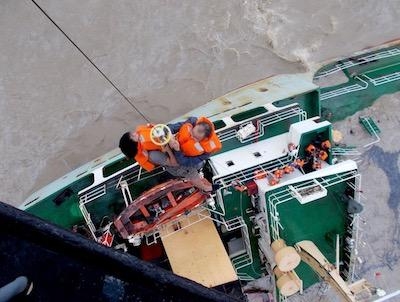Super Puma, Dauphin Helicopters Deployed During Tropical Storms
Hong Kong Government Flying Service rescued 70 people during the recent tropical storms that struck Hong Kong and Macau, employing its Super Puma and Dauphin helicopters to bring them to safety.

Located at the northern edge of the South China Sea, Hong Kong’s landscape comprises an urban core of skyscrapers surrounded by lowland countryside, hills, and coastal industry. On 23 August, Typhoon Hato hit the city of 7.3 million inhabitants and nearby Macau. The signal 10 tropical storm – the highest storm rating given in that region – was followed four days later by tropical storm Pakhar, a signal 8. Winds up to 118 kilometres per hour caused power cuts across the region, and storms ravaged the coastline, capsizing boats and flooding parts of the city. Many lives were lost in Macau and Guangdong province, and hundreds of thousands were left without power and water supplies. Many more had to be rescued in seas whipped by hurricane-force winds.
Among those in the fray was Government Flying Service (GFS), a multi-mission government department which operates three Super Puma Mk2 and four H155 Dauphin helicopters. Year-round, GFS performs a host of missions for the city of Hong Kong, including search and rescue (SAR), counter-terrorism, customs and anti-smuggling, peacekeeping, and airborne law enforcement. In addition, GFS’s helicopters fight fires in the hills, perform aerial surveys, and transport VIPs.
On August 22, a day before tropical storm Hato made landfall, a four-person crew on one of GFS’s AS332 L2 Super Pumas was called out on what would be the first of three separate rescue campaigns spanning one week.
“The distressed vessel was located 168 kilometers (approx. 90 nautical miles) southwest of Hong Kong, in the South China Sea, and eight survivors were involved,” says Captain Michael Chan of GFS. “We had to fly towards the typhoon and the bad weather. Because it was quite a distance away from Hong Kong, providing back-up support to our crew was difficult.” The helicopter was assisted by a Challenger 605 fixed wing aircraft. All eight men were rescued and brought safely to land.

A second operation followed on August 23 and 24, when Hato swept into Hong Kong. From GFS’s headquarters at Hong Kong International Airport where he was overseeing the mission, Captain Chan remarked that airlines had cancelled flights and rain continued throughout the day, at times lashing the building horizontally. “The wind was so strong that it was forcing rainwater through the windows,” he says. “It rained all day, sometimes heavily, which reduced visibility down to hundreds of metres. Because of the strong wind throwing raindrops against the helicopter blades, when the crews came back, we had to perform detailed maintenance inspections on the helicopters.”
The Super Pumas were well-equipped for the emergency. With two Turbomeca Makila 1A1 engines providing enough power to fly in gale-force winds, and putting the large cabin to maximum use, the GFS crews rescued 51 people over the two-day operation. “The location was closer, about 35 km (19 nautical miles) southwest of Hong Kong,” says Captain Chan. “It was slightly less stressful than the operation on 22 August because we are more familiar with the area. But it was complicated, because people were in distress on more than ten vessels. Some of them were on board sinking ships, some were in the water. We just tried to rescue whoever we saw. The next day we received information that 19 vessels had been in distress in the area.”
A third rescue occurred on August 27, 144 kilometers (78 nautical miles) away to the east as tropical storm Pakhar gained strength, and resulted in the rescue of 11 survivors.
Altogether, GFS mobilized 92 personnel over the course of six days. Throughout, GFS’s entire fleet was either in the air or on call, an achievement that would not have been possible without the operator’s engineering support and the technical and logistics support of Airbus’ regional hubs. In total, the helicopters were deployed on 17 sorties and 70 people were safely rescued. “This is a major achievement for GFS,” says Captain Chan, “and a major achievement for the Super Puma.”
(Images provided with Airbus news release)
 ANN's Daily Aero-Linx (05.02.24)
ANN's Daily Aero-Linx (05.02.24) ANN's Daily Aero-Term (05.02.24): Touchdown Zone Lighting
ANN's Daily Aero-Term (05.02.24): Touchdown Zone Lighting Aero-News: Quote of the Day (05.02.24)
Aero-News: Quote of the Day (05.02.24) ANN FAQ: Contributing To Aero-TV
ANN FAQ: Contributing To Aero-TV NTSB Final Report: Cirrus Design Corp SR20
NTSB Final Report: Cirrus Design Corp SR20




